#asw 116
Text

(- so who's wearing your skin?)
episode 23 of revolutionary girl utena, the terms of the duelist, aired on this date 26 years ago.
#a softer world#revolutionary girl utena#shoujo kakumei utena#a softer world remix#rguedit#asw 116#ep: terms of the duelist#mikage and mamiya#souji mikage#mamiya chida#anthy!mamiya#3 2023
197 notes
·
View notes
Text

all my synapses fire wrongly now; good // original
#a softer world remix#a softer galileo#yukaoru#character death cw#asw 116#tantei galileo#kindan no majutsu#s03e00#moteasobu#s02e00#tg: mine: edit#that au where she didn't survive that case#it's up to you whether this text indicates a real world cause or if it's supernatural; maybe it's her ghost#maybe he's dying#i showed this one to eldest; it got an 'oof' from her
2 notes
·
View notes
Text
0 notes
Photo

One more thing you ruined for me.
#Supernatural#spn#a softer supernatural#a softer world#asw 116#remix#season2#02.01#In My Time of Dying#sam#john
48 notes
·
View notes
Text

USS Essex (LHD 2) 🇺🇸 Amphibio Assault Ship Wasp class in service since 1992. Since 2000 its Port Base is Sasebo, Japan. General Features: Relocation: 41,200 tons. Length: 257 meters. Sleeve: 32 meters. Armour: • 2 Sea Sparrow missile systems. • 2 missile systems RIM-116 RAM. • 2 Phalanx CIWS systems. • 3 Cannons M242 Bushmaster. • Browning M2 Machine Guns. Units: 7 in service (1 down x 🔥). Aircrafts: Dependent on the mission: Standard supplement • 6 AV-8B Harrier. • 4 AH-1W SuperCobra. • 12 CH-46 Sea Knight. • 3 CH-53 Sea Stallion. • 3 UH-1N Huey. Assault: • 24 CH-46 Sea Knight. Maritime control. • 20 AV-8B Harrier o F-35B Lightning II. • 6 ASW helicopters.
67 notes
·
View notes
Text

DOUBTS HAS BEING PLANTED IN SHIAS MIND ABOUT NOT TO CURSE OR USE HARSH WORDS AGAINST THE ENEMIES OF ALLAH {SWT} AND THE AHLUL BAIT {AS}.
What is the verdict of Islam on using strong language against the enemies?
Among the frequently debated topics is usage of strong language against enemies of Allah and the Progeny of Prophet Muhammad (asws).
Some are of the view that we should show restraint in the matter and avoid abusing and attacking genealogy even of the enemies of Allah and the Ahlul Bait of Prophet Muhammad (asws). They maintain this goes against the high standards of ethics and etiquette established by Allah, the Prophet (saww) and Ahle Bait (as) according to the Holy Qur'an and the reliable Sunnah in dealing with the enemies.
Reply:
First let us cite specific instances of the Prophet (saww) and his progeny addressing the enemies of Allah to understand their mannerism / Sunnah in this regard.
In the battle of Ahzab, when Amr Ibn Abd Wurd taunts the Muslim forces, the Prophet (saww) addressed his companions:
Who will take on this dog?
Reference: Tafseer al-Qummi (r.a.) v 2 p 183
Tafseer al-Safi v 4 p 175
When Ibn Ziyad threatened to kill Meesam al-Tammar (ra) like no one has ever been killed in Islam, Meesam responds:
My Master (Imam Ali (as)) had informed me that one born of an immoral woman will kill me…
Reference: Al-Ikhtesaas p 76
When Marwan Ibn Hakam threatens Imam Hussain (as) with dire consequences for avoiding allegiance to Yazid (la), Imam Hussain (as) retorts:
Oh son of the blue-eyed woman (reference to Marwan’s mother and her infamous reputation among Arabs)…
Reference: Al-Irshad v 2 p 33
Sharh Nahj al-Balaghah v 20 p 116
On receiving Yazid (la)'s demand for allegiance,
Imam Hussain (as) says:
The illegitimate son of the illegitimate father has demanded that I choose between faith and degradation, far from us is degradation…
Reference: Tuhuf al-Uqool p 241
Al-Luhoof p 97
The infallible (as) act in harmony with the Qur'an
By consensus it is established that the Holy Prophet (saww) and his infallible progeny are paragons of ethics, who never acted against divine command even for a moment.
So when they behave in this manner with the enemies, then it is definitely in line with the Sunnah of Allah.
Scholars have pointed this out, as we see in the explanation of the researcher of Maqtal al-Husain (as) who writes:
Although the Islamic Shariah admonishes us from calling others with nicknames (Surah Hujurat (49:11)) and from attacking their genealogy, the Imams (as) who were the Proofs of Allah (Hujah of Allah) over creation knew all complex matters and never went beyond what is divinely decreed.
Since we are so far away from their time, we are bound to surrender to the judgment of the infallible Imams (as) with regard to anything they did or said particularly when it is in agreement with the Holy Qur'an, the source of all religious decrees (Ahkam).
The taunting applied by the Imams (as) is like the taunting of Allah (swt), the Almighty with regard to Walid ibn Mughairah al-Makhzumi (father of Khalid Ibn Walid) who is described in the Holy Qur'an:
Ignoble, besides all that, base-born (Surah Qalam 68: 13)
Linguistically, زَنِيمٍ (zaneem) is one who is born outside wedlock, that is, illegitimately. According to the rules of genealogy, he is one whose lineage is claimed by someone else.
In Kanz al-Ummal (v 1 p 156) of Muttaqi al-Hindi, the Prophet (saww) is quoted as saying:
The عُتُلٍّ زَنِيمٍ is one who is a lowly-born degenerate.
Alusi in his Tafseer – Ruh al-Maani v 29 p 28 records:
Walid’s father – Mughairah, claimed him eighteen years after his birth.
So, if the Holy Qur'an, the fountainhead of moral excellence and mysteries charges someone and calls him with such a bad name, and it is the Book that is recited day and night, we should not be surprised to see Imam Hussain (as), the son of the Prophet (saww) charging Marwan with the dishonorable title of ‘son of blue-eyed woman’.
Maqtal Al-Hussain (as) by Abdul Razaq al-Muqarram under chapter of Yazid Ibn Mu'awiya (la).
Also worth considering is that when a fact is so well-known and documented among the people of the time that it is a testimony to one’s character and is joined with his name, then it can hardly be considered as a nickname or abuse.
Marwan’s immoral character and genealogy was not a secret. It was so common that not just Marwan even his progeny – Bani Marwan were addressed as sons of the blue-eyed woman and fruits of the ‘accursed tree’.
Ibn Athir records: People used to taunt the descendants of Abdul Malik Ibn Marwan as sons of the ‘blue-eyed woman’ (immoral woman).
Reference: Al-Kamil v 4 p 75
Marwan Ibn Muhammad Ibn Ashath used to say: The children of Marwan (Bani Marwan) were always taunted as descendants of the blue-eyed woman.
Reference: Tarikh al-Tabari v 8 p 16
Entire chapter devoted to abusing enemies
Our scholars have devoted entire chapters to the subject of cursing and abusing enemies. For instance renowned scholar Shaikh Hurr al-Amili (ra) has introduced a chapter (39) in volume 16 of Wasail ul-Shia with the title:
‘Chapter of Obligation of Cursing the People of Innovation and Abusing them and Cautioning the People against them and Discrediting them fearlessly’
With the backing of the Holy Qur'an, Sunnah of the Prophet (saww) and his infallible progeny (as) and research of our scholars on the subject, abusing the enemies of Allah is hardly cause for confusion and controversy.
1 note
·
View note
Photo

ASW 116. now it's a journal comic? Boring.
3 notes
·
View notes
Note
So we end up flattening Shagrat Airbase. Is there anything stopping Syria from sinking the Bush in response?
Well, lets see. Is there?
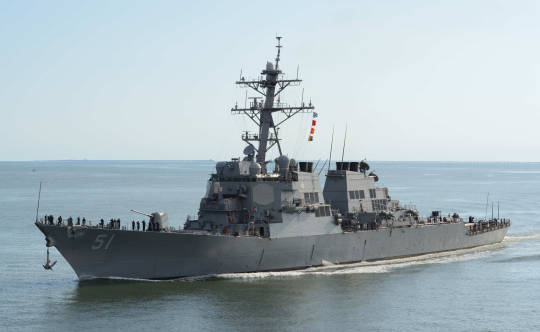
This is an Arleigh-Burke class destroyer. It’s a modern air-warfare destroyer, which means it’s mainly designed to carry a fuck-ton of anti-aircraft missiles, to shoot down aircraft, and incoming hostile anti-ship cruise missiles. Newer marks also carry two large helicopters, which make it a potent anti-submarine platform as well.
It does many things, but first and foremost it’s designed to protect the carrier.

This is a Ticonderoga-class cruiser. This ship is designed, from the keel-up, for one job, and one job only. It has more VLS cells than a Burke (a full 122 to a Burke’s 96,) but most importantly its increased size houses more computers and crew for operating the Aegis Combat System, a sophisticated computer network that links all the other ships in the fleet using it (such as Burkes, the carrier, any and all aircraft launched by ships or carrier, etc.,) and use that data to co-ordinate the sensors and weapons systems of every ship in the fleet to track and engage incoming targets. This floating command post’s Aegis system (Aegis = “shield” in ancient Greek) had its origins in the New Threat Upgrade systems first developed when rapidly advancing electronics tech in the early 80s was making cruise missiles smart enough that ECM couldn’t just make them do loop-de-loops. This is when missiles were first optimized not for engaging cruise missiles heading towards the launching ship, but for engaging missiles heading for other ships that were not them, by flying “lead” pursuits required to engage crossing targets, rather than the old and very inefficient/ineffective “lag” pursuits.
In short, the “one job” this ship is built to do is to protect another ship - the carrier.

This is a nuclear-powered fast-attack submarine, a Virginia class. The second-best anti-submarine weapon in the world is an aircraft (commonly carried in large numbers by these things called aircraft carriers,) and the first one, is another submarine.
One of these accompanies every Carrier Battle Group. To protect the carrier.
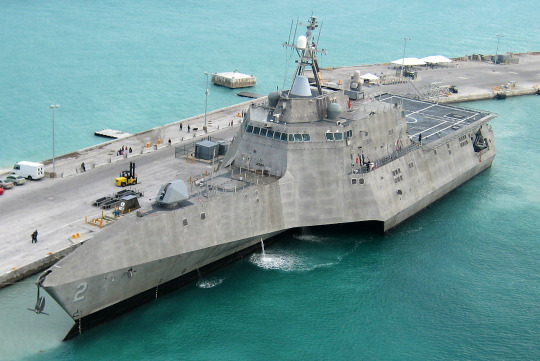
This is an Independence-class Littoral Combat Ship, which has been built to execute several different missions, but the primary and most important one is fending off swarms of small speedboats and other asymmetric threats in places like the Strait of Hormuz. It’s also highly capable as a modern anti-submarine warfare platform, with a towed VDS sonar and extensive ASW helicopter capacity.
In other words, it’s custom designed to fend off Iranian-style tactics when a carrier is transiting the Strait. This ship, too, defends the carrier.
Now lets talk missiles.

This is an SM-1 on the twin-arm launch rail. This could fire two Standard missiles at a time. This was far, far too few to fight off big swarms of cheap cruise missiles targeting some big, vulnerable ship, like, say, a carrier. The first Ticonderoga cruisers were armed with these, and were notable for having two, instead of just one like most escort ships, which made them more capable of protecting the carrier.
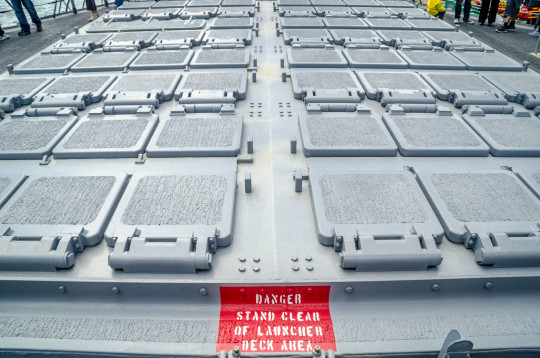
This is a Vertical Launch System, a design that allows the very rapid ripple-firing of many, many weapons at once, specifically to put weapons in the air to counter big saturation-attack swarms of incoming cruise missiles. The Aegis Combat System was designed to properly employ this weapon and the vast number of weapons it could fill the air with, specifically to counter the missile saturation attacks designed to overwhelm the defenses of the carrier.
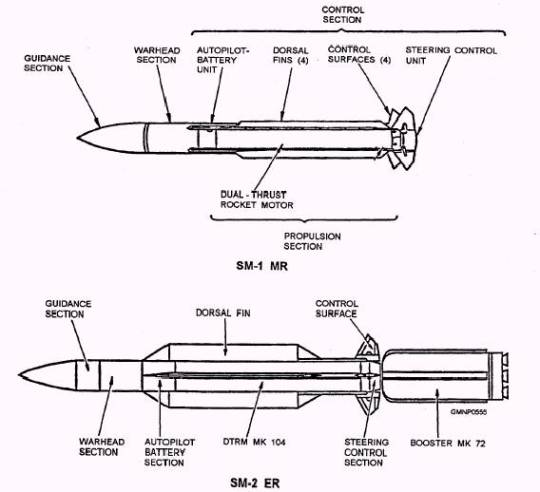
This shows an SM-1 (roughly similar to the modern SM-2, a much-upgraded development of it,) and the SM-2 ER, which adds a honking huge rocket booster to it to grant a lot more range. While an SM-2 reaches about 50 nautical miles or so, the SM-2 ER can reach out a staggering 130 nautical miles.
This increased standoff range is to make it easier to kill aircraft before they can launch missiles at the carrier.
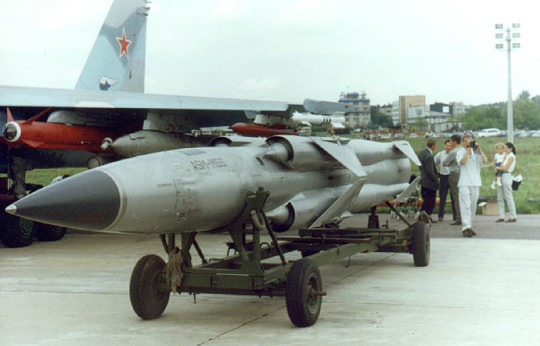
This is a supersonic sea-skimming anti-ship cruise missile known as the “Moskit,” one of a number of similar weapons that the Soviets intended to launch at NATO ships from Tu-22 Backfire bombers. The general idea of these massive weapons was simple - they had very long range, further than the SM-2ER above, so they could avoid the defenses of, and thus kill, the carrier.

This is an F-14 Tomcat, a swing-wing, high-speed fleet defense interceptor. The entire reason for this aircraft’s existence - and for the huge fucking missile it carried -
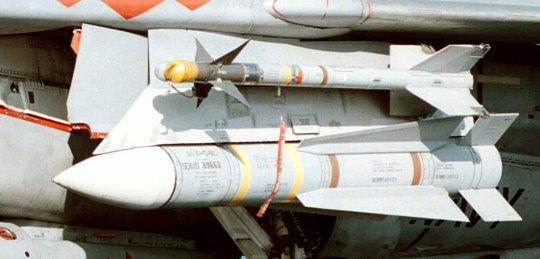
- with its 100 nautical mile range, was to hunt down and murder Backfire Bombers from even longer range. This aircraft and missile were literally made for and designed around each other; an entire, complete weapons system with just one job.
They protected the carrier.
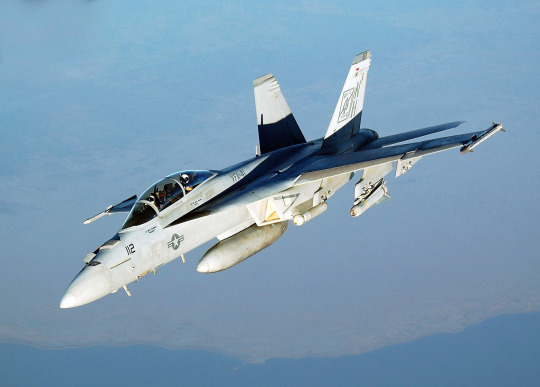
This is an F-18E Super Hornet. With the latest marks of the AIM-120D, which can reach almost 70 goddamn miles, it can pretty much do what the F-14 did, except at lower cost and more reliably because Technology. What it cannot do, the F-35 can, due to being able to get much closer before being detected, and that’s without the possible purchase of the British Meteor, a super-long-range missile that’d be an excellent replacement for the Phoenix - and is already slated for fielding with the British F-35. However, the F-18 as is can protect the carrier. It is good enough to protect the carrier.
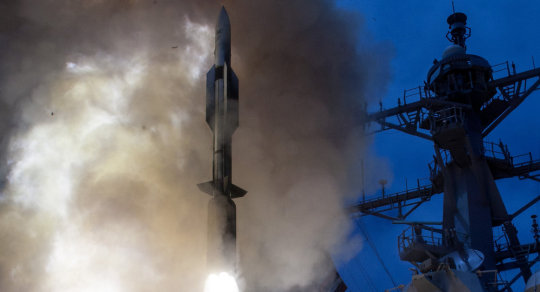
This is an SM-6. The Navy decided that “good enough” wasn’t good enough, so they took an SM-2, took out the guidance, and replaced it with a terrifying Terminator borg-brain equipped with the radar seeker of an AIM-120 so it can hunt down and murder targets autonomously, with no support from the launching ship. Combined with targeting data from an E2D Hawkeye AWACS aircraft (launched by a carrier) and routed through the Aegis combat system, this weapon can engage sea-skimming missiles well over the horizon.
This missile can also kill other ships and it can even shoot down ballistic missiles, but its main role is to protect the carrier.

This is a RIM-7P Sea Sparrow. It’s basically an AIM-7 put onto a ship, where it worked much better than it ever did as an air-to-air weapon. It has a great reputation for reliability and accuracy, and is still in use by many NATO allied nations worldwide. It was commonly used as a point-defense weapon to protect the carrier.
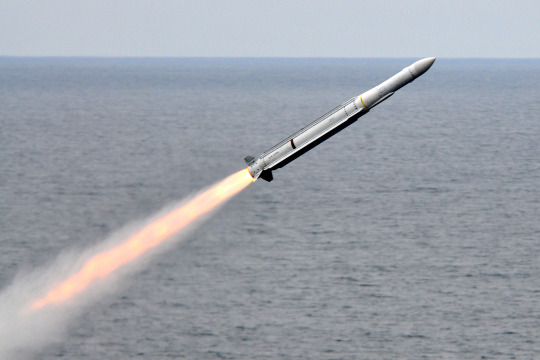
This is an “Evolved” Sea Sparrow, or ESSM, which has about as much in common with the original Sea Sparrow as ducks do with horses. It has more than double the range of the original (30+ nautical miles compared to 15 or so) which puts it closer to a medium-range SAM, but the US still considers it a point-defense weapon. It’s more accurate, can be packed 4 to the VLS cell, and is slated to receive an active radar seeker in a future upgrade.
This now arms the ships that protect the carrier.
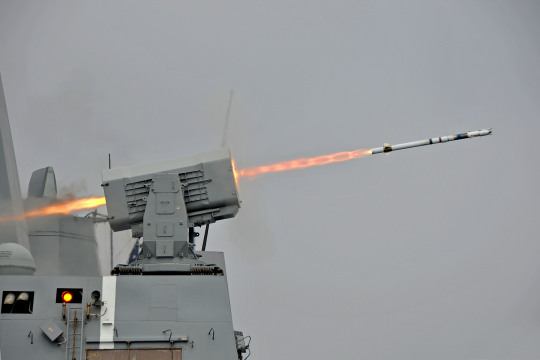
This is what the carriers themselves now use - the RIM-116 Rolling Airframe Missile. It has only slightly less range than the old Sea Sparrow, but makes up for it by getting to the target much faster, important for blowing them up far enough away to avoid damage and for giving you breathing room for follow-up shots if you want. Unlike a CIWS gun, like the Russians and almost everyone else still rely on for the last-ditch point defense, this thing can engage multiple targets at once, can hit targets at about ten times the effective range, is far lighter, and is much more accurate and reliable.
These are mounted on, or being retrofitted to, every carrier to protect them.

Now for a nine-gun blast from the past. This is the USS South Dakota, lead ship of her class. She displaced 35,000 tons and made 27 knots at maximum speed.
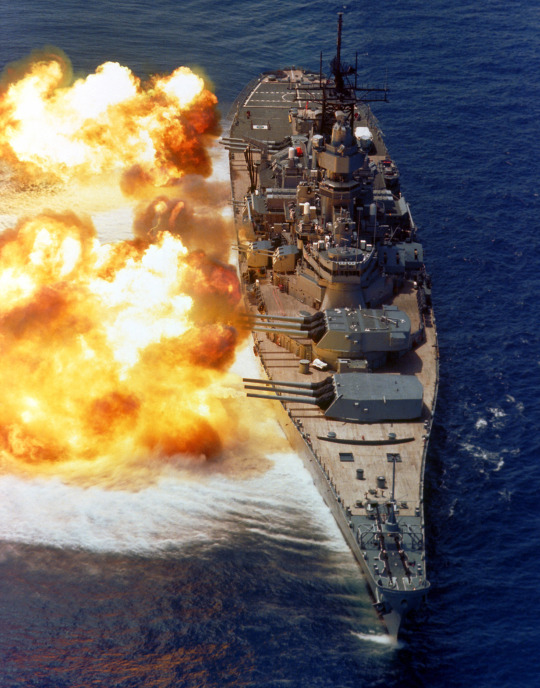
This is the USS Iowa, lead ship of her class. She’s basically the same design as the South Dakota above, but for two differences - she made 33 knots or so, and she weighed 45,000 tons.
Why would the Navy invest 10,000 tons more ship for a measly 6 knots increase in speed - especially when it didn’t make much difference in battleship combat?

This is why - the Iowa could keep up with the carriers, and by that point in the war, the only role for any ship that was not a carrier was usually protecting a carrier. This is the USS Midway, a WWII-construction carrier that served till the 80s.

This is the USS New Jersey on Nov. 8th, 1944, with the USS Hancock in the background, photographed from the USS Intrepid (another carrier.) The New Jersey is protecting the carriers.

This is the USS Iowa in the late 80s or early 90s. In this picture, she is leading a fleet of ships, and that fleet of ships is surrounding the ship they are there to protect, which is a carrier.
This picture can be confusing to the uninitiated, who have let their love of the majesty and engineering of a bygone era corrupt their understanding of the modern world, I have prepared a simple diagram to help you understand the kinds of ships present in this image:
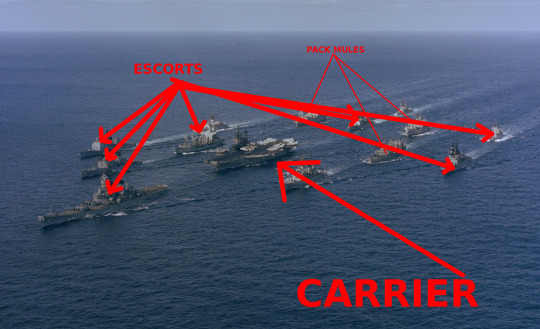
So you see, anon, the thing stopping Syria from sinking the carrier is SEVENTY FUCKING YEARS OF NONSTOP OBSESSION WITH DOING NOTHING BUT PROTECTING THE FUCKING CARRIER.
Does that answer your question, anon?
52 notes
·
View notes
Photo
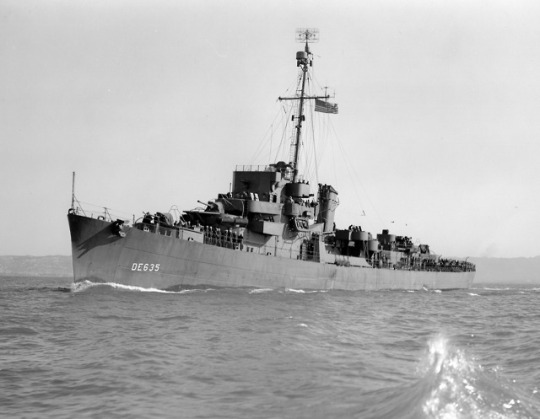


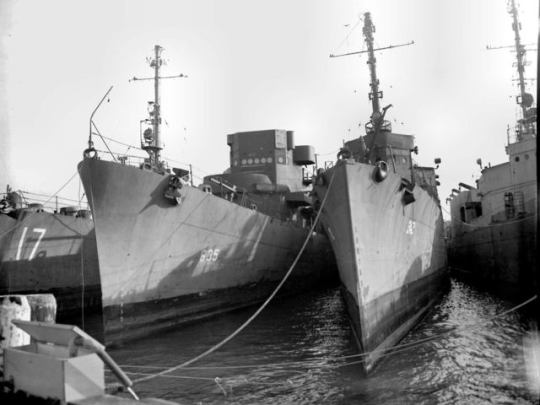
Seventy-five years ago today, on 19 May 1944, USS ENGLAND (DE-635) sank Japanese submarine I-16, the first of six submarines ENGLAND would destroy in May.
She honored John Charles England, born in Harris, Missouri, on 11 December 1920. He enlisted in the Naval Reserve on 6 September 1940, and was commissioned an ensign on 6 June 1941. On 3 September 1941, he reported for duty aboard the Battleship USS OKLAHOMA (BB-37). Ensign England was killed in action during the Japanese attack on Pearl Harbor on 7 December 1941, when OKLAHOMA was torpedoed and capsized.
His namesake, USS ENGLAND, was launched on 26 September 1943, by Bethlehem Steel Company in San Francisco, California. She was sponsored by Mrs. H. B. England, the mother of Ensign England. The ship was commissioned on 10 December 1943, with Cdr. William B. Pendleton in command.
ENGLAND arrived at Espiritu Santo on 12 March 1944, from San Francisco, Pearl Harbor, Funafuti, and Guadalcanal. She took up escort duty between Espiritu Santo and Guadalcanal, occasionally sailing to Noumea, and once to the Marshalls.
On 18 May 1944, with two other destroyer escorts, RABY and GEORGE, ENGLAND cleared Port Purvis on a hunt for Japanese submarines during a passage to Bougainville. Thanks, in part, to Executive Officer John Williamson’s previous duty teaching ASW tactics at Miami, during the next 8 days, she was to set an impressive record in antisubmarine warfare, unmatched by any other American ship.
She hunted down and sank 1-16 on 19 May, RO-106 on 22 May, RO-104 on 23 May, RO-116 on 24 May, and RO-108 on 26 May. In three of these cases, the other destroyers were in on the beginning of the actions, but the kill in every case was ENGLAND's alone. Quickly replenishing depth charges at Manus, ENGLAND was back in action on 31 May, to join with four other ships in sinking RO-105.
This superlative performance won for ENGLAND a Presidential Unit Citation, and the assurance from the Chief of Naval Operations, Admiral E. J. King, "There'll always be an ENGLAND in the United States Navy." His pledge was fulfilled 6 October 1960, when DLG-22 was assigned the name ENGLAND. Sadly, the promise has not been kept today.
Through the summer of 1944, ENGLAND sailed throughout the northern Solomons, providing the escort services necessary for the building up of bases. She also continued to provide escort services that aided the preparations for the renewed assaults on Japanese territories to the north, and the provision of supplies to garrison forces on the islands of the southwest Pacific.
In August, she underwent repairs at Manus, and between 24 September and 15 October, voyaged from the Treasury Islands to Sydney, Australia. From the Treasuries she sailed, guarding a convoy to Hollandia, where she arrived on 18 October. Then, on the 26th, she got underway on the first of two voyages to escort reinforcement convoys to newly invaded Leyte. She returned to Manus and local escort duty on 2 December.
From 2 January 1945, ENGLAND escorted convoys between Manus and Ulithi, the major base for operations of the carrier task forces, and later to be the staging point for the assaults on Iwo Jima and Okinawa. The escort vessel sailed to Kossol Roads in February, bringing in a convoy later routed on to the Philippines, and then resumed her duty on the Manus-Ulithi sea lanes. She sailed from Ulithi on 23 March for the pre-invasion bombardment of Okinawa.
Then she returned to Ulithi to join the screen of two cruisers, guarding them back to Okinawa to join the 5th Fleet just after the initial assault on 1 April. Between 6 and 17 April, she voyaged to Saipan, screening empty transports. Next, she took up a screening and patrol station north of the Kerama Retto.
On 9 May 1945, while on station, ENGLAND was attacked by three Japanese dive-bombers. Gunfire from the ship blew off one wing of the first suicider, but failed to deflect the kamikaze from its one-way mission. The plane crashed into ENGLAND’s starboard side, at the main deck, below the bridge. A heavy explosion soon followed, and a burst of smoke and flame engulfed the destroyer escort's pilothouse and bridge. ENGLAND raced along out of control.
The minesweeper, VIGILANCE (AM-324), rang up full ahead and went to ENGLAND’s assistance. ENGLAND was brought under control and stopped, about four miles east of where she had been kamikazed. At 1920, VIGILANCE pulled alongside the burning destroyer escort. VIGILANCE found heavy fires blazing from the forward mess hall, up through the wardroom, forward 20-millimeter clipping room, radio room, pilothouse, and flying bridge. Afterwards, when ENGLAND’s fires were under control, VIGILANCE took the destroyer escort under tow.
Underway for the northern entrance of Kerama Retto at 2135, the two ships arrived at their destination two hours later. ENGLAND’s total casualties were horrific, with 37 of her men killed or missing, and 25 wounded. When ready for sea, ENGLAND sailed on to Leyte, where she received temporary repairs, putting her in shape for the long voyage home. On 16 July 1945, she arrived in Philadelphia for permanent repairs and conversion to a high-speed transport.
The end of the war, however, halted this work. She was decommissioned on 15 October 1945, and sold for scrap on 26 November 1946. This was the end of one of the great destroyer escorts.
0 notes
Text
Global Signals Intelligence Market Share, Trend, Segmentation and Forecast to 2023
The global Signals Intelligence market size is expected to grow from USD 12.8 billion in 2018 to USD 15.6 billion by 2023, at a Compound Annual Growth Rate (CAGR) of 4.1% during the forecast period. The major driving factors for the SIGINT market are increasing terrorism, growing defense budget of major countries across the globe, and modernization or replacement of an aging defense system.
Browse 48 market data Tables and 41 Figures spread through 116 Pages and in-depth TOC on "Global Signals Intelligence Market by Type (Electronic Intelligence (Elint) & Communications Intelligence (Comint)), Application (Airborne, Naval, Ground (Vehicle-Mounted, Soldiers, & Base Station), Space, & Cyber), and Region - Global Forecast to 2023"
Request a Sample Report @ https://www.marketsandmarkets.com/requestsampleNew.asp?id=192913423
The major SIGINT market vendors include BAE Systems (UK), Lockheed Martin (US), Northrop Grumman (US), Thales (France), Raytheon (US), Elbit Systems (Israel), General Dynamics (US), Israel Aerospace Industries (Israel), Saab (Sweden), Mercury Systems (US), Rolta India (India), Rheintmetall (Germany), Systematic (Denmark), Harris (US), and Cobham (UK). These players have adopted various growth strategies, such as partnerships, agreements, and collaborations, and new product launches, to further expand their presence in the global SIGINT market. New product launches, partnerships, and agreements have been the most adopted strategies by the major players from 2016 to 2018, which helped them innovate their offerings and broaden their customer base.
BAE Systems is one of the leading players in the global SIGINT market. It is one of the leading aerospace and defense companies in the world. It operates through 4 significant segments, namely, air, maritime, land, and cyber. In the field of SIGINT market, the company offers S-3000 Signals Intelligence and Information Operations Systems, Tactical SIGINT Payload (TSP), and Eclipse SIGINT products. The company adopted organic growth strategies such as new product launches and expansions. For instance, in November 2018, BAE Systems announced the launch of the WEnDL system to enhance air traffic situational awareness for military aircraft pilots.
Northrop Grumman is one of the leading vendors in the SIGINT market. It is a global defense and aerospace technology company providing products, systems, and solutions to commercial and government customers worldwide. Its aerospace systems primarily focus on areas such as ISR, strike operations, communications, earth observation, and space science. Northrop Grumman follows both organic and inorganic growth strategies and has focused on increasing its product portfolio with the help of strategies such as agreements and new product launches. For instance, in June 2016, Northrop Grumman signed an MOU with Ultra Electronics to deliver new Maritime Domain Awareness (MDA) and Anti-Submarine Warfare (ASW) capabilities for Northrop Grumman's family of autonomous systems.
Browse Complete Report @ https://www.marketsandmarkets.com/Market-Reports/signals-intelligence-market-192913423.html
0 notes
Text
Should HMS Queen Elizabeth be fitted with her own missile defences?
In an earlier article, we considered how the RN would use layered defence to protect the Queen Elizabeth Class aircraft carriers. There has been particular concern about the lack of defensive missiles fitted to the ship themselves and here we focus on the advantages and disadvantages of fitting the CAMM(M) Sea Ceptor system.
Should the QEC be fitted with Sea Ceptor? The short answer is yes but the long answer is that it would be more complex than it may first appear. A very crude estimate would be £25 million per ship to fit and integrate the system. (Not including the purchase of additional missile stocks). With so many other competing priorities for the RN’s constrained resources, it must be recognised that any upgrade to the carriers is likely to remain a long-term ambition.
The case against
Adding complex weapon systems to an aircraft carrier is unattractive for a number of reasons. From and engineering and operations point of view it is preferable to outsource the task to escorts specifically designated to protect other vessels.
The QEC were designed to maximise the flight deck and hangar space available for aircraft and there is no internal space earmarked for missile silos. Fitting Sea Ceptor would probably involve adding the silos, one each side on the edge of the flight deck. Additional fire and blast risk to the ship made by adding munitions would have to be evaluated. The silos would need some form of external ballistic protection if placed on the side of the ship, otherwise, they could add vulnerability even to small arms fire or RPGs. Methods for safely embarking and removing missiles when alongside also need consideration.
When surface to air missiles (SAM) are launched, they leave behind smoke and a debris trail. This is an impediment to safe aircraft operations due to the risk of foreign object damage (FOD) caused by ingesting debris into jet engines. Before flying operations could restart, a time-consuming FOD inspection of the deck would be needed which could present tactical difficulties if there is an urgent requirement to generate aircraft stories quickly.
Installation of missiles would require integration with the ship’s radars and operations room. The missile guidance system must be set up so as not to interfere with both the ship’s and its aircraft’s radars and communications. There is another greater challenge to deconflict the system with friendly aircraft. Missiles designed to react in seconds to defend against supersonic threats have to be largely automated so the system must have a robust IFF system (Identification Friend or Foe) to ensure the carriers own aircraft are not engaged. Flight paths around the carrier also need to be designed to ensure they avoid the missile arcs. Additional warfare personnel would also be required in the operations room to control the system and weapons engineers needed to maintain it.
All of these challenges can, and have been, surmounted on other carriers but it is easy to see why it may appear attractive to place the missiles on escort ships.
Despite not having a point defence missile, the QEC does have some hard-kill defences will have 3 x 20mm Block 1B Phallax guns and 4 x 30mm Automated Small Caliber Guns (ASCG). These guns systems provide a measure of last-ditch protection from missiles. Phalanx is effective and may be able to break up missiles but at close range may not do enough to dissipate its kinetic energy and debris could still damage the ship.
Some historical context
HMS Invincible fires a Sea Dart. Despite the large blast deflector behind the launcher, the flight deck is covered in smoke and flying operations were adversely affected.
The Invincible class carriers that preceded the QEC in service were originally fitted with the GWS-30 Sea Dart designed to defend against high and medium altitude air attack. These ships were conceived as anti-submarine ’through deck cruisers’ to operate in the Norwegian Sea where they might expect intense Soviet air and missile attacks. During the Falklands conflict, HMS invincible fired 6 missiles in anger, although the targets were later assessed as spurious. Based on 1960s technology, Sea Dart comprised a large magazine, deck launcher, blast shield, two fire-control radars and miscellaneous below deck equipment. Once fitted with their Phallax CIWS, in such a small carrier, additional space for aircraft was ultimately considered more important and the cumbersome Sea Dart was removed from all three carriers in the mid-1990s. The older carrier HMS Hermes was also fitted with the Sea Cat GWS-22 point defence missile system. Originally developed in the 1950s it could be radar, CCTV or manually aimed but was dangerously obsolete by the 1980s while still fitted widely across the RN fleet. Historically, fitting guided missiles to aircraft carriers was clearly considered worthwhile by the RN.
Early in the development phase of the CVF programme (that ultimately delivered the design for the QEC), BAE Systems was tasked with investigating the cost and feasibility of fitting the PAAMS air defence missile system. Some initial CVF concepts showed the Sampson radar and silos for Aster-15 missiles. Other BAE concepts showed the CFV fitted with the simpler Raytheon Sea RAM.
In 2002 the first round of cost-cutting measures was applied to the design concepts and the requirement for the Aster missile system was predictably deleted. In late 2003 another cost-cutting design review saw the deletion of all hard-kill weapons systems (including Phalanx) and a reliance on soft-kill defences alone. Fortunately, this folly was later reversed.
French aircraft carrier Charles de Gaulle fires an Aster-15 missile. The ship carries 32 missiles in two double 8-cell A-43 Sylver launch silos, one on each side of the ship at flight deck level. (Photo: MBDA)
The case in favour
The nations’ flagship may have upwards of 1,600 souls on board, cost at least £3 billion to construct and carry an air group potentially worth another £2 billion. Shortcuts in the protection of these expensive assets for modest savings do not seem to make sense. As discussed in an earlier article there is a proliferation of ever-faster anti-ship missiles that put surface fleets at risk.
The PAAMS fitted to the Type 45 destroyers is arguably the best air defence system at sea today and the RN rightly has great confidence in the system to protect the fleet. The T45 may embark a maximum of 48 Aster 15 and Aster 30 missiles (Whether the MoD actually has sufficient stocks to provide a full outfit for all deploying ships is doubtful). The Aster is a very effective missile but as fail safe back up, plans to add an additional close range PDMS to the T45 in the shape of the Raytheon Sea RAM were shelved as a cost-saving measure early in their development.
Salvoes and leakers
Assuming an adversary is able to accurately locate the carrier battle group, the most likely form of above-water attack will be a salvo of missiles intended to arrive simultaneously and overwhelm defences. The Type 45 is designed to handle multiple engagements but if enough missiles are fired, some may still get through. It is these ‘leakers’ that are the compelling reason to fit a PDMS to the carrier itself. The Type 45 needs to be in the right place, at the right time, every time to protect the carrier. This does not allow for the possibility of PAAMS becoming serviceable or the attack coming from a blind arc or any number of human or technical failures occurring at the wrong moment. Sea Ceptor on the QEC reduces the gamble that the T45 or other escorts will always perform perfectly, while it is clearly desirable to have as many layers of protection as possible in the face of potential mass attacks.
The Type 23 and future Type 26 frigates are armed with Sea Ceptor and can potentially provide air defence for the carrier. When assigned as close escort, this may restrict them in their critical anti-submarine role where they may need to operate some distance away from the self-generated noise of the carrier group. During the Falklands war, the two modern ASW frigates fitted with the only effective PDMS, Sea Wolf we required to spend much of their time on arduous goalkeeping duties, conforming exactly to the movements of the carriers.
At the time the QEC design was conceived, the RN expected to commission 12 Type 45s and have an escort fleet totalling around 30 vessels. As everyone is now painfully aware, there RN got just 6 Type 45s and its escort fleet is down to 19, with insufficient personnel even to man this modest number. The assumption that QEC will have plenty of escorts to protect her is in tatters. Either pretty much the entire available escort fleet must be dedicated to her protection or we are reliant on foreign escorts with the political limitations and operational challenges that brings.
American carrier USS Theodore Rosevelt fires a RIM-116 Rolling Airframe Missile (RAM). It lacks the range or guidance sophistication of Sea Ceptor or Aster but can destroy incoming missiles further from the ship than Phalanx. Note the launcher sited below flight deck level avoiding blast and debris limiting flight operations. (Photo: US Navy)
Everyone else is doing it, why can’t we?
A quick survey of large aircraft carriers in service across the globe reveals that every other navy has opted to fit defensive missile systems. The US Nimitz class and the newer USS Gerald R Ford class have 4 mounts for RIM-7 / RIM-162 Sea Sparrow or RIM-116 RAM in addition to their Phalanx mounts. The ancient Russian carrier Admiral Kuznetsov is armed with 195 3K95 Khinzal SAMs. Even the Chinese navy, a newcomer to the carrier game has fitted 3 x HQ-10 PDMS to the Liaoning which is essentially a trials and training platform and of course, the French navy has fitted Aster-15 to the Charles De Gaulle. Does the RN possess some unique tactical insight that qualifies the Queen Elizabeth class to sail the seas as the only large aircraft carriers in the world not fitted with their own defensive missile system?
Yes we CAMM
When the QEC were being designed the only proven option for a PDMS would have been the ageing GWS-26 Sea Wolf. Still an effective system, it requires dedicated fire-control radars and would be much more complex to install than Sea Ceptor. The Common Anti-Air Modular Missile (CAMM) project that delivered Sea Ceptor has now given the RN a great opportunity to retrofit a very capable new system to older vessels as it has a much smaller equipment footprint than its predecessor. It does not require dedicated fire-control radar and can be cued using the Artisan radar already installed on the QEC. The missiles are initially cold-launched by a compressed air-driven piston before the rocket motor ignites about 30 meters above the ship. This innovation allows the launch cells to be smaller and lighter without the need for ducting arrangements for blast and efflux. The ship also avoids being temporarily enveloped in smoke and toxic fumes, particularly important for personnel working on the flight deck. The Type 23 frigates carry their missiles in a sealed protective canister. On launch, it breaks out of the top of the canister, expelling some debris. Using silo doors instead, similar to the Sylver launchers, could overcome this issue. Sea Ceptor benefits from a range of around 25km, offering an area defence capability comparable with Aster 15 and well beyond the point defence range of RIM-116 or Sea Wolf.
At the heart of this dilemma is a deeper question about whether UK forces are properly equipped to take on peer or even near-peer opponents (whether in coalition or not). Our potential adversaries may conclude the QEC are semi-showpiece vessels, only really safe to operate in fairly benign conditions against unequal opponents (which in the main, has been the convenient experience for western navies in the past few decades). The failure to properly replace the RN’s obsolete Harpoon anti-ship missiles is another case in point. Alternatively, for a relatively modest investment, we could avoid risky compromises and fit much more powerful defensive and offensive armament to our warships which are otherwise essentially excellent platforms.
Related articles
Sea Ceptor specification (MBDA)
Royal Navy aircraft carriers – vulnerable or fit for the fight? (Save the Royal Navy)
How vulnerable is the Royal Navy’s surface fleet to a new generation of weapons? (Save the Royal Navy)
HMS Argyll successfully test-fires Sea Ceptor
from Save the Royal Navy http://www.savetheroyalnavy.org/should-hms-queen-elizabeth-be-fitted-with-her-own-missile-defences/
0 notes
Text
First introduced into the PLA Navy service in 2014, Type 052D (NATO reporting name: Luyang-III class) is the latest variant of the Type 052 family, featuring a number of changes over the previous Type 052C (Luyang-II class) variant. Designed to provide area air defence, Type 052D employs an improved flat-array AESA and a universal 64-cell VLS capable of launching a variety of missiles from the same standard missile cells. These improvements put Type 052D on a par with the latest destroyers deployed by Western navies.
Programme
Following the completion of six Type 052C hulls, Shanghai Jiangnan Changxing Shipbuilding Co., Ltd. began to build two hulls of a new class of multirole missile destroyer. The new destroyer, designated Type 052D, is similar to the previous Type 052C in hull design, but its superstructure is slightly higher and slopes inward at a greater angle to provide further reduced radar cross-section. It also features a new active phased array radar (APAR), featuring larger radar arrays utilizing a liquid-cooling system. Type 052D also features a new single-barrel 130-mm main gun, and a HHQ-10 short-range SAM launcher on the stern.
The most significant change on Type 052D is its universal 64-cell vertical launch system (VLS). Unlike the VLS on Type 052C, which can only launch the HHQ-9 air-defence missile, the new VLS allows missiles of different types and sizes to be carried and launched from the standard missile cells. As a result, Type 052D can carry a variety of air-defence, anti-surface, and anti-submarine weapons according to its mission requirement, providing much greater flexibility and also a rapid-fire launch capability against the various hostile threats.
Type 052D is the ultimate design of the PLA Navy’s 052 family of destroyers, being constructed in a significant number to replace its ageing destroyers. Five hulls had already been commissioned into service as of January 2017, with another 12 hulls either undergoing sea trial or under construction. In addition to the Shanghai-based Jiangnan Changxing Shipyard, some of these hulls are being constructed at Dalian Shipyard in northeast China.
Universal Vertical Launch System
Two universal 32-cell (4 x 8) Dual Hot/Cold-launch VLS are located on the bow deck and amidships respectively. It is the first Chinese VLS to have been developed to to GJB 5860-2006 National Military Standard, which allows launch of missiles using either ‘Cold’ or ‘Hot’ launch method. The rectangle-shaped VLS cell is similar to the Hot-launched VLS on the Type 054A (Jiangkai-II class) missile frigate, but without the shared exhaust vents between the rows of launching tubes. Instead, it utilises a more advanced concentric canister launch (CCL) method, which was first pioneered by US Navy in the mid-1990 for Mk 41 VLS upgrade.
Missiles that can be carried and launched from Type 052D’s universal VLS include:
HHQ-9 long-range SAM;
HHQ-16 medium-range SAM;
HHQ-10 short-range SAM (four missiles in a single cell);
YJ-18 anti-ship cruise missile (ASCM);
In addition, it has been rumoured that the VLS can also carry and launch the CJ-10 land-attack cruise missile (LACM) and CY-5/Yu-8 rocket-propelled torpedo, but this claim has not been confirmed.
Short-Range Air Defence
A single 24-cell HHQ-10 short-range SAM is fitted on the stern deck atop the helicopter hangar. The missile launcher is similar to the U.S. Navy RIM-116 in arrangement. Derived from the TY-90 short-range AAM, the HQ-10 is fitted with a dual passive radar-/infrared-homing seeker and has a maximum range of 9 km. An improved variant is reportedly fitted with an independent active infrared seeker, with a maximum range of 10 km.
A seven-barrel 30-mm Type 730 CIWS is installed on the bow deck ahead of the bridge. The weapon system has a maximum rate of fire of 4,600—5,800 rounds/min and a maximum range of 3 km. Each CIWS has its own independent power-supply, as well as a Type 347G (EFR-1) fire-control radar (6 km detection range against airborne targets of RCS 0.1m2) and an electro-optic director (5—6 km tracking range).
Guns
The main gun on the bow deck is an indigenous H/PJ-38 single-barrel 130-mm gun developed by Zhengzhou Institute of Machinery and Electronics (713 Institute) and built by the Second Inner Mongolia Machinery Plant. The H/PJ-38 is modelled after (but not a direct copy of) the Russian AK-130 automatic naval gun, and can be operated in fully automatic mode from the radar control system, from the shipborne optical sighting system, or laid manually. The gun can fire 86.2 kg projectiles at a maximum rate of 70 rounds/min to a maximum range of 23 km.
Anti-Submarine Warfare
Type 052D has two triple 324-mm torpedo launchers (B.515S copy) for the Yu-7 (Mk-46 Mod 1) active/passive acoustic-homing anti-submarine torpedoes. The Yu-7 carries a 45 kg warhead and has a maximum range of 7.3 km and a maximum speed of 28 knots. The depth of search/attack is 6—400 m.
The four Type 726-4 18-barrel (3×6 arrangement) chaff/decoy launchers on the aft deck can also be used to fire ASW rockets if necessary.
Phased Array Radar
Type 052D is fitted with the improved H/LJG346A (Type 346A, NATO reporting name: ‘Dragon Eye’) multifunctional active phased array radar (APAR) system developed by Nanjing Research Institute of Electronic Technology (CETC 14 Institute). Each rectangle-shaped radar array consists of several thousands of S-band transceiver modules for long-range air search and a C-band module for HQ-9 SAM targeting.
Compared with the Type 346 APAR on Type 052C, the new radar features four larger radar arrays, presumably housing more radar transceivers. The curving radar arrays resulted by the need for air circulation on the earlier APAR on Type 052C have been replaced by flat arrays, suggesting the adoption of a liquid cooling system instead of the mixed air and liquid cooling system on earlier APAR on board Type 052C.
Other Sensors
Other sensors onboard Type 052D include:
Type 517H-1 (NATO reporting name: ‘Knife Rest’) long-range 2D air search radar;
Russian MR331 Mineral-ME (NATO reporting name: ‘Band Stand’) for AShM fire-control;
Indigenous Type 344 (MR34) radar for main gun fire-control;
Indigenous Type 364 (SR64) surface search radar;
Indigenous Type 347G (EFR-1, NATO reporting name: ‘Rice Lamp’) fire-control radar for the Type 730 CIWS;
A hull-mounted H/SJD-9 medium-frequency sonar for active/passive search and attack.
Aviation
The destroyer’s stern hangar accommodates one Kamov Ka-28 (NATO codename: Helix) antisubmarine warfare (ASW) helicopter. Carrying various weapons including torpedoes and deep charges, the helicopter can operate in all weather conditions up to 200 km from the host ship. Alternatively, the destroyer can carry an indigenous Z-9C helicopter.
Propulsion
The propulsion is in the form of CODOG, consisting of two Ukraine-made DA80/DN80 (or their Chinese licensed copies) gas turbines each rated at 32,600 hp (24 MW) and two Shaanxi diesels (Chinese copy of the MTU 20V956TB92) each rated at 8,840hp (6.5 MW), giving a maximum speed of 29 knots.

Specifications
Displacement:......6,900 t (full load) Length:............N/A Beam:..............N/A Draft:.............N/A Speed..............29 knots Range:.............N/A Crew:..............280
Ship List
Name No. Builder Fleet Launch Comm Decomm Kunming 172 Jiangnan Changxing South Sea 30 Aug 2012 21 Mar 2014 – Changsha 173 Jiangnan Changxing South Sea 19 Dec 2012 12 Aug 2015 – Hefei 174 Jiangnan Changxing South Sea 1 Jul 2013 12 Dec 2015 – Yinchuan 175 Jiangnan Changxing South Sea 28 Mar 2014 12 Jul 2016 – Xining 117 Jiangnan Changxing North Sea 26 Aug 2014 22 Jan 2017 – Urumqi 118 Jiangnan Changxing North Sea 30 Dec 2014 Jun 2017? – Xiamen 154 Jiangnan Changxing East Sea 7 Jul 2015 2017 – Guiyang 119 Dalian North Sea 28 Nov 2015 2018 – Nanjing 155 Jiangnan Changxing East Sea 28 Dec 2015 2018 – ? 156 Jiangnan Changxing East Sea 14 Jun 2016 2018 – Chengdu 120 Dalian North Sea 3 Aug 2016 2019 – Nanning 157 Jiangnan Changxing East Sea 26 Dec 2016 2019 –
Type 052D Luyang-III Class First introduced into the PLA Navy service in 2014, Type 052D (NATO reporting name: Luyang-III class) is the latest variant of the Type 052 family, featuring a number of changes over the previous…
0 notes
Note
As a CIWS of last resort, the RIM-116 looks like it'll be hard to reload in a pinch. Will modern day engagements be over before it comes into play?
Very much so. Remember that US ships cannot reload their Vertical Launch Systems at sea, either - in fact, this is one reason the US is pouring lots of money into development of laser based defenses, and hyper-velocity guided cannon shells (themselves the precursors of guided railgun slugs,) to counter the magazine-exhaustion tactic. Such weapons cannot handle a fraction of the missile swarm a loaded VLS can, but they can make the ship invulnerable to such tactics as pegging missiles at the ship a few at a time - just enough to force missiles to double up on targets to be sure of engaging all threats within the engagement window - to exhaust the magazines, then sinking a defenseless target.
But that tactic - though possible - is very, very expensive, and very, very weak in many ways. The biggest weakness is the inherently defensive nature of it; it supposes an almost inexhaustible supply of both missiles and launch platforms. To paraphrase Mazer Rackham, when you go on expeditionary warfare, you have what you brought with you and nothing more. I.e., what fits in your carriers, your ships, and whatever your intercontinental bomber force can muster - and the only nation with a sizable intercontinental bomber force left anymore is the USA, since the Soviet Union collapsed. So the Chinese can peg missiles at us all damn day from shore-based/island-based SSM launchers, but they can’t go far from their own coast and still do that. And even if they have the launch platforms for it, there’s the slight issue of the enemy countering your magazine-exhaustion tactic by just blowing you out of the fucking water.
Hence, overwhelming the enemy and defeating them with the first strike is still pretty damn important; hence why everyone is building VLS ships. Point defense is very much a matter of range, reaction time and “layers,” able to engage threats that have penetrated through the minimum range of other weapons. Not for nothing is the Rolling AIrframe Missile’s defining characteristic speed; it allows it to get out of the launcher and hit that missile while it’s still too far away for the blast to do damage; as well as giving you a longer effective time window to re-engage if one missile misses.
However, in applications where it constitutes the ship’s only air defense, you see a trend towards the proper RAM system, with all 21 missiles and full battle-systems/radar/C3 integration with the host platform. The Freedom-class LCS is an example, and far as I know the Independence (which currently uses the SeaRAM) is slated to receive the fully integrated RAM system in a future upgrade (SeaRAM is still pretty damn good on its own and neatly sidesteps tons of integration/installation work and cost that’d have to be ripped out and/or re-done once they settle on the ship’s final configuration.) A good example of this is the Hellenic Navy’s newest missile gunboats; the Roussen-class. They have a full RAM system, which is an unusual level of protection for that size craft - usually these ships have no protection (aside from “plink away with the Super Rapido and kiss your ass goodbye) because their job is to be modern torpedo boats; the cheapest possible platform for carrying big cruise missiles. For reference, the Chinese Type 022 missile boat only has a single Goalkeeper knockoff (CIWS gun based on the GAU-8,) and that impressed me because it’s more credible air defense than most missile boats get at all.
The RAM launcher can engage multiple targets (unlike a gun) and at three to four times the range (depending on if it’s Block 1 or Block 2) with significantly better pK against maneuvering missiles (which many if not most use.) With the Block 2 versions reaching out 10nm, they’re starting to approach the range of the missiles that we used to consider point-defense, like the RIM-7 Sea Sparrow. CIWS guns used to be the last, last ditch defense to supplement those systems, because even they had a minimum range - now we have a missile that can not only replace the guns at the last-ditch, point-blank defensive role, but they can also reach out far enough to credibly replace many of the short-range SAMs in common use today, like the Aspide.
Generally speaking, “point-defense” and “last-ditch Hail Mary” are synonymous terms. RAM is really, really fucking good point defense - but offensive missiles have not been lollygagging either, which makes people rightly wary of relying on point-defense weapons as the ship’s only air-defense measure. On something like a missile boat, it’s impressive, (for reasons stated above,) but people have waffled on something bigger and more expensive and capable, like the Littoral Combat Ships. I used to criticize the lack of better air defense - say, a Mark 48 VLS (small, lightweight VLS designed and sized for Sea Sparrows or the ESSM specifically,) which could also double as the longer-ranged, light anti-surface missile the LCS was looking for. I’ve been changing my opinion on that the more I look into the LCS, however - everything about the LCS screams “submarine chaser” to me, and indeed, even without all the littoral-friendly features (the anti-swarm boat weaponry with the Hellfire VLS, or the light guns, the well deck, etc;) the 2-helicopter capacity on such a small hull plus the towed sonar array already make it a potent ASW asset, which is something we’ll be wanting given how many potential adversaries focus on subsurface assets. I’m usually a critic of the “lots of cheap ships” approach but there’s some places where it makes sense - sub-chasers being the obvious example. The LCS is more expensive than a mere sub-chaser, but it also does more than chasing subs, too.
The Navy does need some frigates. They used to say the frigate designation; “FFG,” stood for “Forever Fucking Gone” because they deployed so much. Even the Perry-class frigates, which were built as cheap ASW boats, and finished their service without any surface-to-air missiles at all due to the retirement of the single-arm Standard Missile launchers, proved invaluable in extending our reach all over the globe. I’ve said before that bigger, more capable ships are the way to go for anyone who can afford them, but they have a big weakness in that they’re not able to be everywhere at once. If your budget is low enough that you must choose, the smaller fleet of more capable destroyers is the way to go (and it’s certainly the way we went,) but with the Navy looking at a second fleet expansion to meet the needs of the Second Cold War - well, it’s time to embrace the frigate again. They’re even considering re-activating the remaining old Perry class frigates in storage! So the Navy’s plan to build the last 20 LCSs as “stretched” versions to make room for a VLS and more sensor systems - in other words, a proper frigate - seems to me to be the right way to go. Instead of letting mission creep and endless criticism dilute the LCS’s intended missions, we should build the LCSs to do the LCS jobs, and for frigate jobs, we should build proper fucking frigates with the displacement to do their job properly from the get-go.
tl;dr despite the temptation to treat RAM as a primary air defense system, it really is point defense, and should be thought of much the way we’ve always thought of gun-based CIWS - something that comes into play when forced to, not something you rely upon to absorb a blow you’re sure is coming.
1 note
·
View note
Text
Royal Navy aircraft carriers – vulnerable or fit for the fight?
There have been frequent suggestions that aircraft carriers are inherently vulnerable and have been rendered obsolete by a new generation of weaponry. Here we look the range of conventional threats the carriers might face in a high-end conflict and how the RN and the Queen Elizabeth Class are configured to deal with them.
The Russians have called the QEC “large and convenient targets”. A cute sound bite that is frequently rehearsed in various forms across the media and helps create the illusion that they are just passive floating airfields, lacking their own offensive power or the ability to defend themselves. Some forget that a prime purpose of the carrier battle group is to go on the offensive and strike in a proactive way, and if necessary to eliminate what may threaten them before it may mount an attack. That said, it would be complacent to think that any aircraft carrier is invulnerable. Recent developments in stealth aircraft, hypersonic and ballistic anti-ship missiles and ultra-quiet submarines are a threat to all surface combatants. Even the mighty US Navy is stretched to cope in this environment, so how much more is the threadbare RN at risk?
On the day HMS Queen Elizabeth arrived in Portsmouth for the first time we met Commodore Andrew Betton, commander of the UK Carrier Strike Group and asked him if he considers the RN can offer the ship adequate protection, particularly if faced with high-level threats. He replied “The maritime task group operates with layers of force protection, some of which is delivered by ships & aircraft. We also have satellite surveillance to support our understanding of what’s around us. We can bring in extra layers of protection when needed. Every deployment of the carrier & structure of task group around will be based on an intelligence assessment of the threat likely to be faced and the operational tasking.” These layers of protection and defensive measures the UK is able to provide the QEC are worth closer examination.
Seven layers of protection
1. Situational awareness
The outer defence of the Carrier Strike Group (CSG) are aircraft such as the P-8A Poseidon’s, satellite imagery, undersea acoustic sensors, and even basic human intelligence could all contribute to this awareness. Depending on the circumstances and the ability to collect this data, this kind of information may be plentiful at times or almost nonexistent on other occasions. History has proven for example, that land-based aircraft, even if dedicated to the task is almost incapable of sustaining round the clock protection or intelligence to naval vessels. It is always extremely challenging to secure and maintain real-time data on distant threats. This works both ways, to attack the CSG from distance, the enemy also needs accurate location data on ships that may cover over 400 nautical miles in 24 hours.
The QEC and some of the RN’s escort ships now benefit from some exceptionally capable new radars. The high-resolution Artisan 3D (Type 997) radar has a range of over 100nm. The carrier’s (Type 1046) S1850M long range air search radar has a range out to 200nm. The large size of the QEC allows the aerials to be mounted high above the waterline, extending the range at which sea-skimmers can be detected.
2. Carrier aircraft
The first active line of defence are the F-35B Lightnings flown from the carrier itself. Able to strike land targets, and intercept aircraft and attack ships that threaten the CSG. A major strength is that the F-35 has exceptional sensors and can be networked with other aircraft to monitor a large area, feed data back to the carrier and respond quickly. A potential weakness here is the un-refuelled combat radius of the F-35B (without drop tanks that compromise stealth and handling) at approximately 500nm.
The Searchwater radar of Crowsnest helicopter has an approximate maximum range of 150nm and operate up to 450nm away from the carrier with sorties lasting up to 4.5 hrs. As the range of anti-ship missiles increases, the combat radius and limited number of aircraft (12-24?) that can be deployed against potential launch platforms become critical.
3a. Area defence (air)
The Principal Anti Air Missile System (PAAMS) carried by the T45 is possibly the best and naval air defence system afloat anywhere in the world and is theoretically capable of detecting and simultaneously engaging multiple aircraft and missiles travelling up to Mach 4. The Sea Viper missiles provide an air defence umbrella that extends out to about 65 nautical miles over the CBG.
Once the propulsion problems have been fully cured by the mid-2020s, with just 6 Type 45s, the RN is likely to be able to assign a maximum of two these destroyers for escorting the CBG. Even if the MoD actually holds sufficient missile stocks for all the T45s to embark a full outfit, they can carry a maximum of 48 and cannot be replenished at sea. One can have great confidence an initial saturation attack would be successfully repelled, but repeated attacks could exhaust limited ammunition quickly. The comparable AEGIS-equipped Arleigh Burke destroyers of the USN can embark up to 96 missiles and the Ticonderoga cruisers up to 122 missiles of various kinds. The US Carrier battle group would typically be escorted by 4-6 of these AEGIS ships. At present, the RN has no ability to destroy ballistic missiles (anti-ship or otherwise) but there is the potential for the RN to buy the Aster Block 1NT for the Type 45 in future.
3b. Area defence (underwater)
Of all the threats to the CBG, the submarine presents the most danger as they become increasingly quiet and hard to detect. Submarines are usually the best means of finding and sinking other submarines. Of the 7 SSNs possessed by the RN, it would be expected that one will be assigned to protect the CBG (The USN typically assigns 2 SSNs to a carrier group). Usually, the SSN will work as a ‘freelancer’, not especially close to the CGB but in the best tactical position to intecerpt and track hostile ships or submarines. The Merlin Mk2 helicopters operating from the deck of the QEC and the escorts are the only other means of prosecuting submarines (unless ASROC missiles are purchased for the Type 26 Frigates). Finding submarines will be the primary job of the Type 23/26 frigates. Their Type 20xx towed array sonar is the usually the best tool for detection at a safe distance away from the CBG. They will then direct the Merlin to the target which can be localised using its FLASH dipping sonar. The escorts all have bow-mounted sonars but detection ranges in both passive and active modes are usually considerably less than that of the towed array, but which time a submarine could be close enough to have achieved a firing position. Unfortunately, despite the quiet electric motors that propel the Type 45, the QEC and the supporting Tide-class RFAs, they all have noisy diesel engines and auxiliary machinery bolted directly to their hulls. Without dampening measures, this radiates noise and vibration into the water which interferes with sonars and may aid enemy submarines in locating the CSG.
The P-8A Poseidons may also be able to contribute to the ASW effort surrounding the carrier, but this would very much depend on the area of operations.
In broad terms area, defence against submarine and air threats is much easier to conduct in the open ocean. It the littorals close to land and in congested and noisy shallower seas, defence of the carrier becomes significantly harder.
3c. Area defence (surface)
A rather obvious gap in the CSG defences is the lack of medium or long range anti-ship missile carried by the RN’s escorts (from 2018 to around 2030 when the FCGWS project may bear fruit). When the Sea Venom missile comes into service the RN will have an excellent weapon for use against fast attack craft or corvettes, but attacking major warships must be delegated to the F-35s or a supporting submarine.
Sea Viper and Sea Ceptor. The ship-launched missile systems key for air defence of the CSG
4. Point defence
Missiles or aircraft that evade the area defences should then encounter the point defence Surface to Air Missile (SAM) systems that protect individual ships or a few ships in close company A point defence SAM would typically have a maximum range of 10-12 nautical miles. The QEC has no point defence system of its own and will entrust this task to its escorting ships. Other navies think differently. The French carrier, Charles de Gaulle is fitted with 16 x Aster 15 SAMs and 2 Sadral SAM launchers. US carriers have both RIM-7 Sea Sparrow SAM and RIM-116 Rolling Airframe SAMs. The new Sea Ceptor SAM fitted to the Type 23/26 frigates looks to be very effective in this role and has significantly greater range than the Sea Wolf system it replaces. The point defence ‘goalkeeping’ mission requires the escort to stay in close touch with the carrier and its arcs of fire may be restricted by the carrier or other ships. At times the frigates may need to operate at some distance away from the carrier in order to deploy towed array sonar and listen for submarines, undisturbed by the self-generated noise of the CSG.
The Type 45 can also provide point defence using its shorter range Aster 15 missiles but the number of ships and available missiles is again the problem. Fitting at least a few Sea Ceptor cells to the QEC would not be especially difficult and this omission has everything to do with saving money and nothing to do with tactical wisdom.
5. Close in weapons systems
The QEC will has a very standard CIWS fit of 3 x 20 mm Block 1B Phallax guns and 4 x 30mm Automated Small Caliber Guns (ASCG). The ubiquitous Phalanx system is used by many navies across the world, is simple and reliable but how it would perform in saturation missile attack is unknown. The ASCGs are cued by electro-optical mounts high on the ship and can be controlled from the ops room. They would probably be very effective against small boat swarm attacks. It is assumed the QEC will also be fitted with a variety of decoy launchers and the Surface Ship Torpedo Defence (SSTD) decoy system. The USN fitting an active variant of SSTD on its carriers that launch mini torpedos to destroy inbound torpedos, rather than just attempt to confuse them.
6. Light weapons and force protection measures
The inner layer of protection consists of a selection of removable M2HB machine guns and Mk44 mini guns on pintle mounts around the ship. On all RN vessels, these weapons are manned on entering or leaving port as protection against attack from small craft or drones. In battle conditions, they may also serve as useful last-ditch defence particularly against aircraft or small boat swarms. Being manually aimed, they are of minimal use against missiles.
7. Damage control and survivability
If the worst happens, the QEC have been carefully designed to withstand significant battle damage. The designers wisely avoided the pressure to reduce costs by cutting corners on construction standards. This kind of protection would be very difficult and expensive to retrofit at a later date and resistance to blast and splinter and flooding provides reassurance that the ship can survive some hits or near misses without catastrophic structural damage and is able to float, move and fight in difficult conditions. The RN is also recognised as a world leader in training its sailors in effective damage control.
Conclusions
This is a whistlestop tour of a very complex subject but this basic assessment shows there are weaknesses that restrict where the QEC could be safely operated without assistance from the US Navy and other NATO nations. By withdrawing from standing commitments, at a stretch, the RN will probably be able to muster 2 destroyers and 3 or 4 frigates to provide sustained escort to the carrier. The QEC and its bare minimum supporting assets do offer the option of mounting an independent British operation but only against a lesser adversary (ie not Russia and certainly not China). Even a ‘Falklands conflict’ style operation would still entail considerable risk, given the slim escort and lack of strength in depth.
No one seriously expects the UK to take on a peer-level opponent alone but beyond the apocalyptic scenario of major state-on-state conflict, the carriers still have huge utility. Even if the RN cannot act independently, the QEC significantly adds to NATO and western naval capability and deterrence which is presently inadequate in the European theatre. The QEC also come with all the other attendant soft-power capabilities such as diplomatic and trade missions, humanitarian and relief operations and the ability to help enforce foreign policy without firing a shot or putting troops on the ground. They are also highly valued by the US who see them as able to plug gaps to relieve pressure on their fleet.
Asked if he expects to operate mostly with coalition warships Cdre Betton said; “Coalition operations are attractive as they spread the burden, and give us a shared authority. But the new carriers are a capability that is sovereign at core and allow us to act unilaterally if we wish”.
from Save the Royal Navy http://www.savetheroyalnavy.org/royal-navy-aircraft-carriers-vulnerable-or-fit-for-the-fight/
0 notes
Photo

Whoa, when you say you've been watching us, does that mean you've been watching us all the time?
#Supernatural#spn#a softer supernatural#a softer world#asw 116#remix#season9#09.14#Captives#kevin#ghost
3 notes
·
View notes